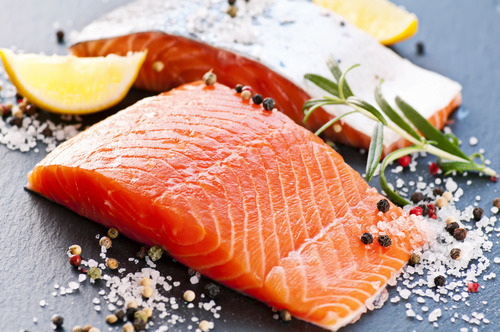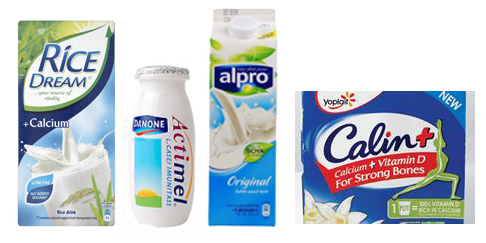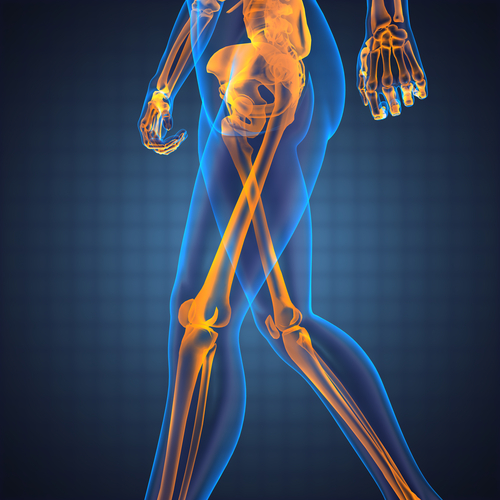Vitamin D has been proclaimed as a miracle panacea connected to everything from the prevention of cancer to mood regulation, yet it’s thought around a quarter of us are deficient. Dietician Claire Donnelly has all you need to know about how much you need and how to get it especially during the winter months
Recently, top surgeon Professor Kefah Mokbel recommended all women from the age of 20 be given vitamin D supplements on the NHS to prevent their developing breast cancer. It’s been linked to immune-boosting and deficiency is believed by some to lead to higher risk of osteoporosis and heart disease. But how far do these claims hold up and how can we ensure our levels are adequate?
Vitamin D is the only vitamin which can be made in the body – when UVB rays from sunlight act on a substance under our skin, a store of vitamin D3 (cholecalciferol) is produced. This store is thought to last us through the winter.
However, there is now concern about widespread deficiency in the UK and the most recent national survey of our eating habits found that up to a quarter of people were D-deficient thanks to a combination of low dietary intake and inadequate sun exposure.
It’s now believed that sufficient vitamin D may not be obtained from sunlight in the UK and one being the low level of sunlight from April to October each year. As for the winter well, look outside. By combining the right sun exposure with some D-rich foods in your diet – especially in the winter – and knowing whether you’re at risk of deficiency, you can get your D levels right.
Getting your D fix
1. Sunlight is considered our key source of vitamin D. But here’s the thing. You need enough sunlight to build up your body’s vitamin D, without exposing yourself to the risk of skin cancer. That’s where the confusion starts. In 2010 the British Association of Dermatologists and Cancer Research UK issued the following advice on safe sun exposure for vitamin D production:
- Expose hands, face, arms and legs for10-15 minutes in the middle of the day, two to three times a week between April and October.
- This is before applying sunscreen.
- But if you’re fair-skinned, have moles and lots of freckles or have a family history of skin cancer, do use sun protection in summer. It’s thought sensible sun protection shouldn’t hinder the body from producing vitamin D.
You don’t need to tan or bronze to a crisp to make vitamin D. The amount of time required is less than the time needed for skin to redden and burn. In fact spending a long time in the sun does not lead to extra levels of vitamin D. Instead the body breaks down any extra vitamin D once it has reached a healthy level.
2. D-rich foods
Vitamin D can also be found in a limited number of foods. Oily fish (salmon, trout, sardines and mackerel) contains the most substantial amount of vitamin D. It is measured in micrograms (µg) or international units (I.U). 1 µg = 40 I.U. You will see either measurement on labels.
An 85g serving of salmon has 10 micrograms (µg).
Egg yolk, meat and liver contain smaller quantities of vitamin D. For example a small portion (180g) of braising steak has 1.4 µg. An egg yolk has 0.3 µg.
Certain breakfast cereals, margarine and infant formula milk are fortified with vitamin D. For example a 30g serving of Special K has 2.5 µg. A 30g serving of Bran Flakes has 1.3 µg.
A bottle (100g) of Actimel drinking yogurt has 0.75 µg.
A glass (200ml) of Rice Dream has 2.5 µg.
A glass (200ml) of Alpro Soya milk has 1.5 µg.
The new Yoplait Cal-in+ yogurt contains 5 µg of vitamin D per pot.
Mushrooms also contain a small amount of vitamin D2 (ergocalciferol). The latter is formed by the action of sunlight on a substance in mushrooms called ergosterol.
WHY YOU NEED VITAMIN D – sorting the facts from the hype
Bone health Vitamin D plays a crucial role in creating healthy bones and teeth. It absorbs the calcium and phosphorus from our diet. Extreme cases of vitamin D deficiency result in osteomalacia in adults and rickets in children. Not enough vitamin D and calcium is also linked to low bone mineral density in adults. This leads to a higher risk of osteoporosis and bone fractures.
In the 21st century we’re faced with the prospect that the Victorian-era disease rickets is making a comeback in England. There has been a reported rise in cases. Contributory factors include:
- poor diets
- inadequate sunshine exposure due to overzealous use of sunscreen by anxious parents
- the lure of computers and gaming consoles mean children are spending too much time indoors.
The Chief Medical Officer, Dame Sally Davies recently called for supplements containing vitamins A,C and D to be made available for free to all under-fives.
As for the hype
Apologies for bursting your vitamin D bubble. But press reports claiming vitamin D protects against type 2 diabetes, cancer, multiple sclerosis and heart disease are grossly exaggerated. Unfortunately research on vitamin D has been portrayed as moving at a Usain Bolt going-for-Olympic-gold-pace.
As Dr JoAnn Manson, MD, DrPH, professor of medicine at Harvard Medical School states, “Although the evidence is promising, it’s currently inconsistent and inconclusive. There isn’t clear evidence for a cause and effect relationship. Many observational studies have suggested a possible correlation between a low vitamin D level and several negative health outcomes. But it’s important to note that correlation does not prove causation.”
In other words there isn’t enough strong evidence at the moment to say vitamin D definitively protects against certain diseases. There’s a need for the highest level of scientific evidence available. This would involve large scale trials on humans to better define the associations which are evident.
However watch this space. Vitamin D is a work in progress. Solid evidence could emerge by 2017, due to a large study called the Vitamin D and Omega-3 Trial (VITAL). It will involve 25,000 U.S. adults and explore the relationship between vitamin D and omega-3 fatty acids, and risk of cancer and cardiovascular disease.
Are you at risk of vitamin D deficiency?
Currently the following groups who are considered at risk of vitamin D deficiency, are recommended to take a daily vitamin D supplement.
- Pregnant and breastfeeding women; people aged 65 years plus; people who are sun avoidant and those who cover their skin when outdoors. These need to take a daily supplement containing 10 µg(equivalent to 400 I.U. of vitamin D).
- Babies and young children aged six months to five years, should take a daily supplement containing vitamin D in the form of vitamin drops to meet the requirement set for this age group of 7-8.5 µg (equivalent to 280 to 340 I.U) of vitamin D a day.
- Babies fed infant formula don’t require vitamin drops until they are receiving less than 500ml (about a pint) of infant formula a day. This is because infant formula products are fortified with vitamin D.
- Breastfed infants may need to receive drops containing vitamin D from one month of age, if their mother hasn’t taken vitamin D supplements throughout pregnancy.
The D-debate
Currently in the UK there isn’t a recommended intake of vitamin D each day for people aged 4 to 65 years i.e. the general population. In 1991 when vitamin D guidelines were established, it was thought that the majority of people in the UK obtained adequate vitamin D from exposure to sunlight.
Fast-forward 22 years and the key issues under debate are:
- Sufficient vitamin D may not be obtained from sunlight in the UK due to a range of complex reasons. The most obvious one being the low level of sunlight from April to October each year.
- Even the colour of your skin dictates how much vitamin D can be produced by your body. Paler skins make vitamin D at a faster rate than darker skins. The latter contain more melanin, which means less UVB rays enter the skin. Thus dark skinned people need more time in the sun to produce vitamin D than fair skinned people. Age is also a factor, as skin production of vitamin D decreases as we get older.
- However it’s still not possible to quantify exactly how much sunlight we need to boost our vitamin D supply.
- It’s unclear how much vitamin D is actually contributed by the food we eat. Official surveys have highlighted that consumption of oily fish in the UK is low, yet it’s the richest dietary source of vitamin D. One researcher has claimed less than 10 per cent of our need for vitamin D is met by food.
- Controversy surrounds what is the most favourable level of vitamin D in the blood for good health. Evidence is needed from scientific research to show clear health benefits and no risks before such a level can be set.
- People who are obese are also at risk of deficiency. It’s speculated that vitamin D is captured inside fat tissue so there is less available for circulation around the body.
The European Union has set a recommended intake of five milligrams daily. Vitamin D guidelines are under review in the UK. An expert committee in the UK is currently conducting a review of the evidence. Again watch this space.
What you need to do
- This winter try to increase your intake of the vitamin D rich foods.
- If you don’t like the foods containing vitamin D, and have been avoiding the sun or not taking a multi-vitamin, seek advice from your GP on taking a supplement. It’s always sensible to check with your GP first, especially if you have a medical condition or you’re taking any medication.
- If you fall into one of the groups at risk of deficiency as detailed above, take the advice on supplementation seriously. It’s thought many pregnant and breastfeeding women are unaware they should be taking a vitamin D supplement.
- If you are of African, African-Caribbean and South Asian origin consider seeking advice from a doctor on vitamin D. If you can’t up your intake of D-rich foods or you avoid the sun, you may require a supplement.
- Vitamin D is found in multi-vitamin formulations. Or you can buy single vitamin D supplements or vitamin drops containing vitamin D (for use by under-fives). These are all widely available at most pharmacies and supermarkets. In Boots you can pick up a pack of 90 tablets providing 10 µg each of vitamin D3 for £2.19.
- Cod liver oil as a vitamin D supplement is not recommended for young children, pregnant women or older people. This is due to concern about the possible toxic effects of the high amount of vitamin A in cod liver oil.
- Avoid OD’ing on vitamin D. More is not better when it comes to nutrient supplements, especially vitamin D. Experts advise taking no more than 25 µg(0.025mg) daily.
- So don’t take more than one supplement containing D. For instance a multi-vitamin plus a supplement solely supplying vitamin D.
- Excess vitamin D is dangerous . Because it’s fat-soluble, it can be stored in the body. Thus it can reach potentially toxic levels resulting in damage to the kidneys. Be sensible – follow the recommended guidelines.
CLAIRE DONNELLY is a Registered Dietitian and has a Masters in Public Health Nutrition. She was the 2012 winner of the annual Caroline Walker essay in public health nutrition. Claire is passionate about health, nutrition and well-being, and is an advocate for lifelong learning.
Like this article? Sign up to our newsletter to get more articles like this delivered straight to your inbox.


























































